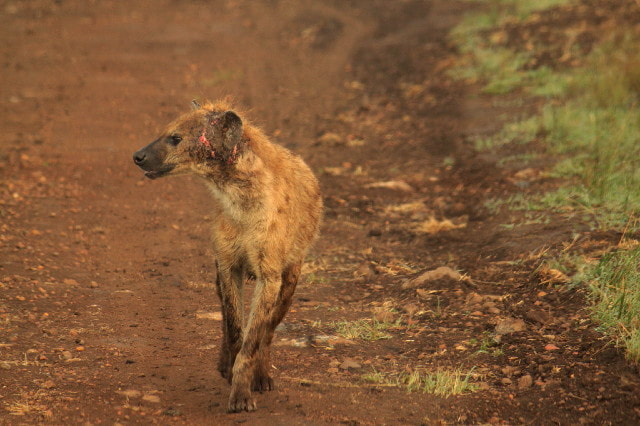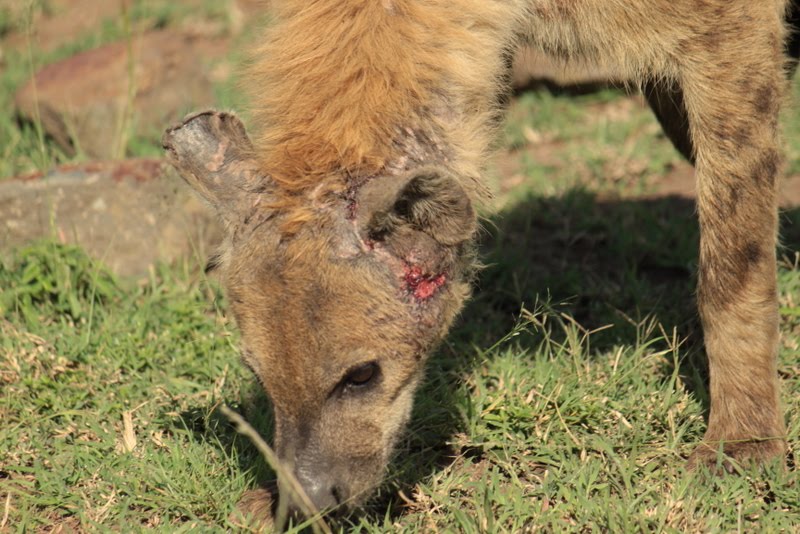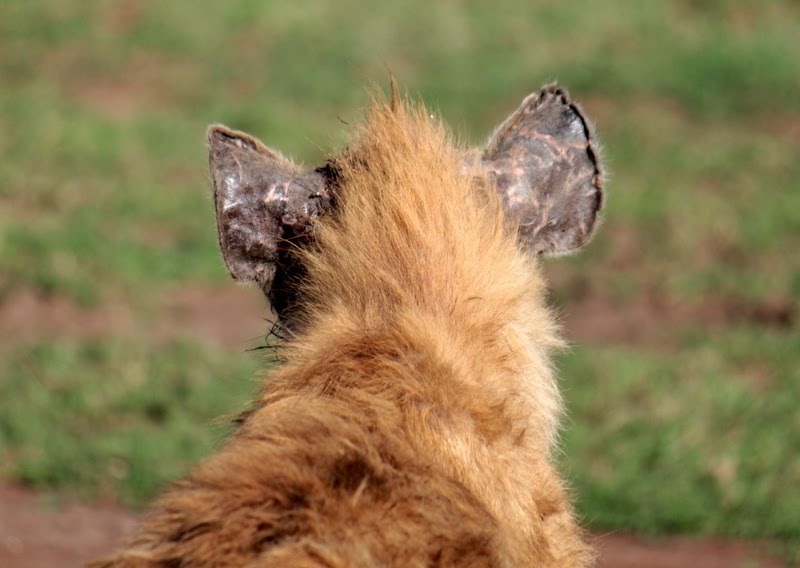|
Author: Andy Gersick This is Andy Gersick. I’m here to study vocal communication and I’m planning a post on that topic soon – hopefully with good clips of hyena calls for readers to click on – but for now I want to talk about some ongoing intrigue in the South clan. The hyena you’re looking at – the one who looks like his head was run over by a lawnmower – is Dolittle. He’s our ranking male in South clan and normally he is as cocky and content as a male hyena can be (which is to say he’s skittish and timid around females but demands respect from the other males). We were frankly stunned when we saw him the other day in North-clan territory with wounds all over his head and neck. We never expect to see members of one clan deep in another’s territory unless they’re immigrant males trying to disperse. As a top male in South, Dolittle shouldn’t have been planning a move. Hanging out in alien-clan territory is a good way to get yourself attacked, so our first thought was that Dolittle must have somehow wandered into North and gotten a beating for it. Now we’re not so sure. Just a couple of weeks earlier we had watched Dolittle behaving like an alpha male in his prime. He was at Orchid Den with Grimace – an unlucky female who’s often in heat but hasn’t managed to produce a viable litter (as far as we know). Apparently Grimace is smelling sexy again, because Dolittle was circling around her with the intense-but-worried interest that typifies a courting male – he would hover as close as possible whenever she sacked out and would follow her in nervous spirals whenever she’d wander, backing off timidly if she looked the least bit annoyed. Every once in awhile, when Dolittle’s spirals took him too far away, Grimace would stop and look over her shoulder at him, almost encouraging him to stop sniveling and catch up. Females aren’t usually inclined to tolerate a male’s presence, much less push him to get closer, so Grimace’s come-hither looks were our best clue that she might be interested in mating. At any rate, Grimace eventually seemed to give up on her anxious suitor and lay down by the den for a real snooze, with Dolittle standing twitchily nearby. At that point, we spotted three other clan males approaching in the tall grass just beyond the den clearing. Dolittle saw them too, and his posture changed completely. He stood up straight and stared intently in their direction, pawing the ground and seeming to send a clear message: Back off. The other changed course to avoid the den and slunk past without even shooting a glance at Grimace. Dolittle was flexing his alpha-male muscles. The animal who showed up in North Territory a few days later was a shadow of that Dolittle. We found him lying in the middle of the road, wounded, exhausted and thin. We decided to hang out and see what would happen to him – half out of scientific interest, half out of worry that the first North animal that saw him would finish him off. But over the next two hours a procession of North-clan hyenas wandered past Dolittle during their morning perambulations, and none of them seemed terribly concerned with the invader. High-ranked Joni gave him an idle sniff – he answered with an intensely submissive posture and she went on her way, trailing young Hooker who barely looked at Dolittle. Later a mixed-sex group of young adults – Leprechaun (m), Arrow (f) and Peepers (f) – thought he was interesting enough to check out from a distance of about 30 meters. Dolittle heaved himself up from his convalescent nap and trotted another 20 meters away, and the three North-ers headed casually in the opposite direction. So now we have a mystery: who or what attacked Dolittle, how did he end up so far from home, and why don’t any of the North animals seem to care? Our best guess at the moment is that North is actually Dolittle’s natal clan, and that whatever happened to get him those injuries sent him back to his childhood home to recover. When young males mature sexually and disperse, their first try is often a failure; when they get tired of being abused in their adoptive clans they often come back home to resume their birth-ranks, get a break from being picked on, and fatten up before making the next attempt. Dolittle is too old to fit this model exactly, and his dispersal to South has been a success up to now, but if he was born in North it may still feel like the safest place to get over a serious trauma. If Dolittle is a North animal, that would explain the tolerant treatment he seems to be receiving from other North-ers. Even if we’re right about that part of it, we still don’t know who gave Dolittle such a thrashing. One possibility is that there has been a mutiny among the South males. If they rose up to depose him, they may have driven him out of South entirely. Audrey DeRose-Wilson recalls a similar event with Rogue, a former number-one male in the Prozac clan. Rogue’s tenure ended suddenly when something triggered an uprising by the other clan males. They turned on him as a group, viciously attacked him and left him severely injured. He loitered around the outskirts of Prozac territory for a few days, then disappeared. He was never seen again. But Dolittle’s injuries may have nothing to do with hyenas – other lab members have speculated that he might have taken a drink at the wrong time and barely escaped from a croc (his wounds don’t look consistent with a lion attack), or even gotten some kind of chemical burn. Two days ago I saw Dolittle a second time, still in North Territory (pictures below). His wounds are healing but he is gaunt and limping badly. The fact that he continues hanging around in North makes me feel more convinced that whatever happened to him happened in South territory. But for now there’s not much we can do to clarify the story. We can only wait to see if Dolittle turns up back in South to resume his reign, or disappears like Rogue.
If you’ve got a theory about what might have happened to Dolittle, post a comment.
0 Comments
Your comment will be posted after it is approved.
Leave a Reply. |
About
Notes From Kenya is a blog run by the students in the Holekamp Lab at Michigan State University, College of Natural Science, East Lansing, Michigan, U.S.A. Archives
July 2020
Categories |



 RSS Feed
RSS Feed